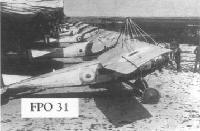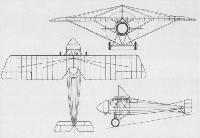
Описание
Страна: Франция
Год: 1915
Фронтовой самолет
Варианты
- Morane-Saulnier - Type L / Моран-Парасоль - 1913 - Франция
- Pfalz - A.I/E.III - 1914 - Германия
- Morane-Saulnier - Type LA / P / Моран-4 / Морчет - 1915 - Франция
- Thulin - D - 1915 - Швеция
- Ольховский В.М. - Моран-парасоль - 1916 - Россия
- В.Кондратьев Самолеты первой мировой войны
- А.Шепс Самолеты Первой мировой войны. Страны Антанты
- В.Шавров История конструкций самолетов в СССР до 1938 г.
- J.Davilla, A.Soltan French Aircraft of the First World War (Flying Machines)
- G.Swanborough, P.Bowers United States Military Aircraft Since 1909 (Putnam)
- Jane's All The World Aircraft 1919
- W.Green, G.Swanborough The Complete Book of Fighters
- C.Owers French Warplanes of WWI. Volume 1: Fighters (A Centennial Perspective on Great War Airplanes 43)
-
А.Шепс - Самолеты Первой мировой войны. Страны Антанты
Истребитель/разведчик Моран-Солнье тип P французских ВВС (1915г.)
-
A.Durkota, T.Darcey, V.Kulikov - The Imperial Russian Air Service /Flying Machines/
Morane Saulnier P #526, unit unknown, circa 1917.
-
A.Durkota, T.Darcey, V.Kulikov - The Imperial Russian Air Service /Flying Machines/
Morane Saulnier P, 19th Corps Detachment, September 1917.
-
В.Кондратьев - Самолеты первой мировой войны
Morane-Saulnier P, 19-й корпусной авиаотряд ВВС России, 1917г.
-
J.Davilla, A.Soltan - French Aircraft of the First World War /Flying Machines/
Morane-Saulnier Type LA of the 21st Squadron of the IRAS.
-
В.Кондратьев - Самолеты первой мировой войны
Русские "Морчеты" французской постройки без вооружения.
-
A.Durkota, T.Darcey, V.Kulikov - The Imperial Russian Air Service /Flying Machines/
Morane-Saulnier P (serial 526). The French supplied a large number of these machines in 1915. Overall finish in plain linen. Metal panels and wheel covers are finished in red.
-
В.Шавров - История конструкций самолетов в СССР до 1938 г.
"Моран-парасоль Р"
-
J.Davilla, A.Soltan - French Aircraft of the First World War /Flying Machines/
Morane-Saulnier Type LA of the IRAS with skis.
-
K.Delve - World War One in the Air /Crowood/
The Morane-Saulnier 'parasol' series ot monoplanes saw extensive use with the French and British. Here is a line-up of mixed types - probably L and LAs - with 3 Squadron RFC in 1915. Their main tasks remained those of reconnaissance, including photography and artillery spotting.
-
H.Nowarra, G.Duval - Russian Civil and Military Aircraft 1884-1969
Russian trainer of 1918, at the Samara Flying School. More purposeful and efficient is the Morane-Saulnier LA, previously in front-line service but now relegated to the role of fighter trainer for advanced pupils.
-
Jane's All The World Aircraft 1919 /Jane's/
Three-quarter Front View of the Type P. Morane-Saulnier "Parasol".
-
W.Green, G.Swanborough - The Complete Book of Fighters
The second fighter version of the Type P introduced twin-gun armament.
-
Jane's All The World Aircraft 1919 /Jane's/
Модификация "Р" выглядела гораздо изящнее предшественников. На ее основе после войны выпускался учебный вариант самолета / Three-quarter Rear View of the Type P. Morane-Saulnier "Parasol". Note the ailerons: unusual in a monoplane.
-
J.Herris - Weird Wings of WWI /Centennial Perspective/ (70)
This Morane-Saulnier P was armed with two guns, one fixed to fire over the propeller arc due to lack of a synchronizer. A monoplane, it required extensive wire bracing, with their associated drag, again without the strength of a biplane configuration.
-
J.Davilla, A.Soltan - French Aircraft of the First World War /Flying Machines/
Morane-Saulnier Type P with fore and aft-mounted machine guns. Renaud.
-
H.Cowin - Aviation Pioneers /Osprey/
The Morane-Saulnier Type P two seat reconnaissance machine was a derivative of the their Type LA. Initially deployed operationally in mid-1916, the Type P was produced with a choice of 80hp Le Rhone, with the French military designation Type XXI, or with a 110hp Le Rhone, when it became the Type XXVI. Seen here is a French operated Type XXVI that had a top level speed of 97mph at 6,560 feet, along with a ceiling of 12.000 feet. Armament comprised a fixed, forward firing gun for the pilot, together with a flexibly mounted gun for the observer. Operated in some numbers by the French military, a much smaller quantity were operated by RFC squadrons well into 1917, with at least 565 Type Ps known to have been produced.
-
J.Davilla, A.Soltan - French Aircraft of the First World War /Flying Machines/
Morane-Saulnier Type P of N 314. The airplane was used as a nightfighter and was based at Malzeville in July 1917.
-
J.Herris - Weird Wings of WWI /Centennial Perspective/ (70)
These two Morane-Saulnier MoS 26 Type P “Parasol” reconnaisance aircraft have been removed from frontline service. However, their usefulness is not yet over. They have clipped wings, for use as “Penguins.”
-
J.Davilla, A.Soltan - French Aircraft of the First World War /Flying Machines/
Morane-Saulnier Type P of Escadrille C 220. These aircraft supplemented, but did not replace, other types then in squadron use.
-
J.Davilla, A.Soltan - French Aircraft of the First World War /Flying Machines/
A Morane-Saulnier Type AC assigned to N 76. This airplane was named Viking II and was flown by Danish volunteer Leith Jenen. A Morane-Saulnier P is in the background.
Другие самолёты на фотографии: Morane-Saulnier AC (MS-23) - Франция - 1916
-
A.Durkota, T.Darcey, V.Kulikov - The Imperial Russian Air Service /Flying Machines/
Smirnov with pilot Alfred Heft from Flieger Abteilung (A)240, Smirnov shot down Heft's aircraft for his fifth confirmed victory, August 23, 1917, Although both men are standing in front of Smirnov's Morane Saulnier I, combat reports indicted Smirnov shot down Heft while flying Nieuport 21 serial number 1514.
Note faulty retouched right wing tip - the triangular fitment on it is in fact the cabane (king post) structure of a distant Morane-Saulnier Type P parasol.Другие самолёты на фотографии: Morane-Saulnier N/I/V (Morane-Monocoque) - Франция - 1914
-
C.Owers - French Warplanes of WWI. Volume 1: Fighters /Centennial Perspective/ (43)
The Morane-Saulnier exhibit at the Vie Salon Aeronautique held in Paris in December 1919. The Aeroplane issue of 7 January 1920, reported that Aeroplanes Morane-Saulnier, Rue Volta, 3, Puteaux, exhibited four machines - three parasol monoplanes and the fuselage of a Type AN. The Type A.I - a high-speed single-seater fitted with either the 120-h.p. or the 180-h.p. Le Rhone, is also a Parasol... but fitted with a wonderfully complex rigid bracing of steel tube below the wings, cross-braced fore and aft with cable, which must add at least cent, per cent, to the drag loads on the wing structure. The machine is said to be designed for "La Haute Ecole d'Aerobatie" and for rapid transport work, and has made the journey, Paris-Rome - 1,280 km. - in 5 hr. 59 min. non-stop. One is left to wonder how much time would have been saved on the journey had it been fitted with a reasonable bracing system.
Другие самолёты на фотографии: Morane-Saulnier AI (MS-27/-29) - Франция - 1917Morane-Saulnier AN - Франция - 1919
-
C.Owers - French Warplanes of WWI. Volume 1: Fighters /Centennial Perspective/ (43)
Single seat conversion of the Morane-Saulnier MoS 21 Type P fighter.
-
C.Owers - French Warplanes of WWI. Volume 1: Fighters /Centennial Perspective/ (43)
The second type of single-seat fighter conversion of the MoS 21 Type P with a Le Rhone 9J nine-cylinder rotary engine. The machine's flying characteristics were probably as tricky as the earlier Morane-Saulnier parasols. The Type P came in three variants. The Type 21 with the casserole type spinner and cowling of the Types N, I, and V with the 110 hp Le Rhone. The Type 24 was a Type P with the 80 hp Le Rhone and smaller spinner. The last was the Type 26 Type P with 110-120 hp Le Rhone and circular cowling similar to the Sopwith Camel and no propeller spinner.
-
C.Owers - French Warplanes of WWI. Volume 1: Fighters /Centennial Perspective/ (43)
Serial MS 1201; this aircraft does not have the large cone that was used on all Morane-Saulniers. It was riveted on to the airscrew as a permanent attachment and caused problems in storage and transportation.
-
D.Mechin - Foreign Fronts of the French Air Force 1914-1919 /Aeronaut/
In parallel to the action of the N 581 and SOP 582 squadrons, the war of the 1916 Berger mission continued... And so do their losses. Here, a Morane LA crushed on July 23,1917 by pilot Jean Robinet, from the Odessa factory (Coll. Albin Denis)
-
A.Durkota, T.Darcey, V.Kulikov - The Imperial Russian Air Service /Flying Machines/
Morane Saulnier Top Views
Другие самолёты на фотографии: Morane-Saulnier G/H - Франция - 1912Morane-Saulnier N/I/V (Morane-Monocoque) - Франция - 1914Morane-Saulnier Type L / Моран-Парасоль - Франция - 1913
-
W.Green, G.Swanborough - The Complete Book of Fighters
The second fighter version of the Type P introduced twin-gun armament.
-
В.Кондратьев - Самолеты первой мировой войны
Morane-Saulnier P
-
A.Durkota, T.Darcey, V.Kulikov - The Imperial Russian Air Service /Flying Machines/
Morane-Saulnier Type P (MoS.21)
-
A.Durkota, T.Darcey, V.Kulikov - The Imperial Russian Air Service /Flying Machines/
Morane-Saulnier Type P (MoS.21)
В.Кондратьев Самолеты первой мировой войны
МОРАН-СОЛНЬЕ P "МОРЧЕТ" / MORANE-SAULNIER P
Развитие типа "Морана-парасоля" с более мощным мотором, увеличенными размерами, усиленной конструкцией и рядом аэродинамических усовершенствований. Изменено вертикальное оперение, установлен кок винта, фюзеляжу придана более обтекаемая многогранная форма. Крылья с элеронами. Самолет спроектирован в 1915 году, в 1916 запущен в серию. Построено 565 экземпляров.
В 1916-1917 годах "Моран Р" применялся французскими ВВС в качестве разведчика на западном фронте совместно с "Парасолями" ранних модификаций. Он заметно опережал своих предшественников по основным летным данным, но был более капризен, строг в пилотировании и не завоевал симпатии летчиков. Ни одной французской эскадрильи не было целиком оснащено "Моранами Р", хотя во многих подразделениях летало по нескольку аэропланов этого типа. В 1916 году 142 машины передано англичанам. 2 дивизиона британских "Моранов" принимали участие в сражении на Сомме.
Несколько экземпляров (предположительно, не более 10) поступило в Россию. Здесь их называли "Моран четвертый" или сокращенно - "Морчет". На русско-германском фронте "Морчеты" недолго применялись, в частности 19-м корпусным авиаотрядом и первой боевой авиагруппой Казакова. В казаковской авиагруппе эти машины поначалу считались двухместными истребителями, но к весне 1917-го их сменили одноместные "Ньюпоры" и "Спады".
ДВИГАТЕЛЬ
"Рон", 110 или 120 л.с.
ВООРУЖЕНИЕ
Первоначально 1 шкворневый (позднее - турельный) "Льюис" в задней кабине, затем стали дополнительно устанавливать 1 синхронный "Виккерс". На российские "Морчеты" ставили также пулеметы "Кольт" или "Мадсен".
Описание:






































